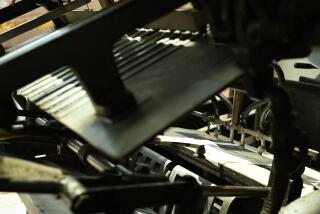Book review: ‘Just My Type: A Book About Fonts’ by Simon Garfield
- Share via
Just My Type
A Book About Fonts
Simon Garfield
Gotham Books: 356 pp., $27.50
Flying in the face of the digital-age mantra that “print is dead,” Simon Garfield’s “Just My Type” takes an engaging look at the world of fonts, the building blocks of everything we read. With wit and insight, he enlivens a topic that few outside the graphic trades might ponder.
He wants to change that.
“We live at a time where we have never had such an engaging choice of fonts from which to design an alluring storefront or sell a product,” explains Garfield, who’s looked at such topics as stamps and the color mauve in his other books. “We walk around, and the history of type beckons from every angle, here a whisper, there an alarm.…”
In 22 chapters, the author examines the ever-changing, almost organic nature of the printed word. The basics of font design are covered here — like serif versus sans serif, for instance, or principles of kerning and line spacing — but Garfield doesn’t overwhelm readers with too many technicalities. Mostly he uses anecdotes to tell how something we take for granted has shaped and shaded our perceptions ever since humans first started carving messages on hard surfaces.
Garfield makes an important point early that, by themselves, letters are meaningless even though their silhouettes and strokes may lend them unique qualities of expression. He then looks at the ways we string together letters to form words and the fonts we choose, describing their good and bad qualities as if they were old friends.
Chapters include a funny call to action against the overuse of Comic Sans (“We Don’t Serve Your Type”) and an exploration of the font featured in Barack Obama’s winning presidential campaign (“Gotham is Go”). He even dishes a little gossip about some of the characters behind the characters, like Eric Gill, who, along with a taste for bizarre sexual experimentation, managed to invent Gill Sans, one of the most iconic and “clean” typefaces of the 20th century.
And then there’s Beatrice Warde, whose passion about type reverberates even today. In addition to being Gill’s friend and “sometime lover,” Garfield tells us, she was a publicity manager for the Monotype Corp. whose passion for printing led to her now-famous declaration, “This is a Printing-Office.” Set in Trajan and hung in her office for all to see, Warde wrote:
From this place words may fly abroad
Not to perish as waves of sound but fixed in time
Not corrupted by the hurrying hand but verified in proof
Friend, you stand on sacred ground:
This is a printing-office.
Trajan was the style of Roman stonecutters and uses all capitals: In an email today, unfortunately, using that style is considered shouting. On the page, however, the Trajan typeface looks like something important is being said and the reader should pay attention.
Elsewhere in “Just My Type” Garfield chronicles how Ikea’s switch from Futura to Verdana for its corporate identity resulted in a “font war,” pitting type purists against the corporate decision makers who instigated the change. Garfield dubs it a “fontroversy” that eventually died down as the new font became as familiar, and eventually as invisible, as the one it had replaced.
Garfield also credits Apple co-founder Steve Jobs for the array of fonts now available at our fingertips. Jobs’ early fascination with calligraphy and letter forms, he explains, later translated into the long pull-down font menus available on desktops everywhere. That’s not always a good thing, the author says, because the overwhelming number of typefaces can be daunting and lead to goofy choices. Freedom of choice, in this case, is not always our friend.
“Just My Type” urges us to put on the brakes and take in the scenery as far as typography goes. Whether you’re a graphic designer or a layperson with no background in this area, reading what Garfield has to say will change the way you perceive the written word forever. It might even lead you to make more discerning choices the next time you have a desktop publishing project in front of you. The take-away from Garfield’s book is simple: Contrary to reports of its premature death, print is very much alive.
More to Read
Sign up for our Book Club newsletter
Get the latest news, events and more from the Los Angeles Times Book Club, and help us get L.A. reading and talking.
You may occasionally receive promotional content from the Los Angeles Times.










